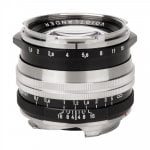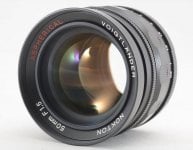ajs
Anthony
Would anyone be able to provide the technical differences in lens design and character between the LTM/L39 Voigtlander 50mm F1.5 Aspherical and the Voigtlander 50mm f/1.5 II MC Aspherical?
When Fred Miranda says' "The new Voigtlander Nokton 50mm f/1.5 II replaces the previous version with an improved optical formula and two aspheric surfaces." is he referring to this older LTM Voigt or the scolloped one? I assume the latter because Hern Tan says, referring to the LTM in 2016, "Unlike the newer M-mount version of this lens, this has a slightly different optical formula, incorporating not one, but two aspherical surfaces.". Which brings me to wonder what the difference is between these two 50mm f1.5 lenses with two aspherical surfaces.
I'm having a difficult time choosing between the two. I have a Canon IVSB II, Canon P (custom painted in black and red), and a Minolta CLE. Plus an M-FX adapter for my XPro-1. So the LTM version would go a long way towards working on three different lens mounts. Although, I already have the Canon 50 1.8 LTM so I don't need another 50mm LTM (haha).
If anyone could write a bit about or direct me towards the history/timeline of these varied Voigtlander 50mm lenses, I'd greatly appreciate it.
Edit: I've found the lens database website which is somewhat helpful on specs. Although, I've encountered several instances where the specs are incorrect (specifically on Zeiss lenses).
https://lens-db.com/cosina-voigtlander-nokton-50mm-f15-aspherical-1999/
https://lens-db.com/cosina-voigtlander-nokton-50mm-f15-aspherical-ii-vm-2020/
When Fred Miranda says' "The new Voigtlander Nokton 50mm f/1.5 II replaces the previous version with an improved optical formula and two aspheric surfaces." is he referring to this older LTM Voigt or the scolloped one? I assume the latter because Hern Tan says, referring to the LTM in 2016, "Unlike the newer M-mount version of this lens, this has a slightly different optical formula, incorporating not one, but two aspherical surfaces.". Which brings me to wonder what the difference is between these two 50mm f1.5 lenses with two aspherical surfaces.
I'm having a difficult time choosing between the two. I have a Canon IVSB II, Canon P (custom painted in black and red), and a Minolta CLE. Plus an M-FX adapter for my XPro-1. So the LTM version would go a long way towards working on three different lens mounts. Although, I already have the Canon 50 1.8 LTM so I don't need another 50mm LTM (haha).
If anyone could write a bit about or direct me towards the history/timeline of these varied Voigtlander 50mm lenses, I'd greatly appreciate it.
Edit: I've found the lens database website which is somewhat helpful on specs. Although, I've encountered several instances where the specs are incorrect (specifically on Zeiss lenses).
https://lens-db.com/cosina-voigtlander-nokton-50mm-f15-aspherical-1999/
https://lens-db.com/cosina-voigtlander-nokton-50mm-f15-aspherical-ii-vm-2020/
Attachments
I have both of these lenses.
The 50mm F1.5 LTM lens is 6 elements in 5 groups. One element is aspherical on both surfaces. Think of this as a classic Double-Gauss with the aspheric surfaces allowing the extra speed rather than adding an extra element as most F1.5 and faster lenses do.
The Nokton-M 50/1.5 V2 is 8 elements in 7 groups. Also 2 aspheric surfaces. Think of it as more elements to reduce the size.
https://www.rangefinderforum.com/node/176280
I kept both lenses, The LTM version- Have the Black version. It is nice.
I posted the test for vignetting on my CCD based M Monochrom. The LTM lens exhibits much less (1-Stop vs 2-stops) at the extreme corners. This is due to the larger front element and longer optical path.
The 50mm F1.5 LTM lens is 6 elements in 5 groups. One element is aspherical on both surfaces. Think of this as a classic Double-Gauss with the aspheric surfaces allowing the extra speed rather than adding an extra element as most F1.5 and faster lenses do.
The Nokton-M 50/1.5 V2 is 8 elements in 7 groups. Also 2 aspheric surfaces. Think of it as more elements to reduce the size.
https://www.rangefinderforum.com/node/176280
I kept both lenses, The LTM version- Have the Black version. It is nice.
I posted the test for vignetting on my CCD based M Monochrom. The LTM lens exhibits much less (1-Stop vs 2-stops) at the extreme corners. This is due to the larger front element and longer optical path.
ajs
Anthony
Exactly what I was looking for, Brian. Thank you!
Would you be able to share a photo of the two lenses sitting side by side to see a size comparison?
Would you be able to share a photo of the two lenses sitting side by side to see a size comparison?
WJJ3
Well-known
FWIW, in a casual test I did of the 50/1.5 LTM I had using a tape measure, it showed increasing focus shift to the rear when stopping down. Not sure if the newer versions were better in this regard.
jankap
Established
The MTF curves are very interesting.
Focus shift to the rear is due to a lens being over-corrected for spherical aberration. Aspherical designs help reduce focus shift by "wiggling it" back and forth, but never eliminate it. To many wiggles- get bizarre bokeh. It's all a trade-off.
Focus shift on the Nokton is minimal, I have not had a problem with it in actual use.
One problem I had and corrected on my LTM Nokton: The second element of the lens became loose and shifted position. This is due to the design of the retaining ring screwing into the barrel. You cannot use a spanner with a flat head to tighten it, must use pointed tips. The retaining ring screws past a rim in the barrel, mine was flush with it. Took off the name ring using strip of rubber for friction, undid the retaining rings, saw the problem and tightened the retaining ring. No more problems.
Focus shift on the Nokton is minimal, I have not had a problem with it in actual use.
One problem I had and corrected on my LTM Nokton: The second element of the lens became loose and shifted position. This is due to the design of the retaining ring screwing into the barrel. You cannot use a spanner with a flat head to tighten it, must use pointed tips. The retaining ring screws past a rim in the barrel, mine was flush with it. Took off the name ring using strip of rubber for friction, undid the retaining rings, saw the problem and tightened the retaining ring. No more problems.
Back from the Beach.
I actually have Three 50mm F1.5 Voigtlander Noktons. The new v2 Nokton is about the same size as the 1950s Nokton, and has a focus mount.
The 50mm F1.5 LTM has the M-Mount adapter and rear cap, size comparison is reasonable. I'm using a cheap 43mm vented hood on the Nokton-M V2. The LTM Nokton has a 52mm filter and original hood on it.
The LTM lens: Mine had an issue with the optical group behind the front element being loose in its fixture. The Retaining ring must be screwed past the ridge, mine was even with it: someone must have used a spanner with flat tips. I used needle-nosed pliers as a spanner to screw the retaining ring in tight, never had another problem with it.
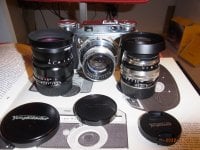
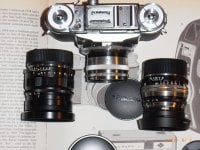
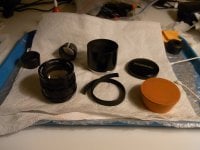
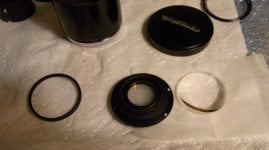
I actually have Three 50mm F1.5 Voigtlander Noktons. The new v2 Nokton is about the same size as the 1950s Nokton, and has a focus mount.
The 50mm F1.5 LTM has the M-Mount adapter and rear cap, size comparison is reasonable. I'm using a cheap 43mm vented hood on the Nokton-M V2. The LTM Nokton has a 52mm filter and original hood on it.
The LTM lens: Mine had an issue with the optical group behind the front element being loose in its fixture. The Retaining ring must be screwed past the ridge, mine was even with it: someone must have used a spanner with flat tips. I used needle-nosed pliers as a spanner to screw the retaining ring in tight, never had another problem with it.




ajs
Anthony
Sonnar Brian I ended up getting a Zeiss 50mm f2 and the Voigtlander LTM. I finally did a test shoot today, along with a Canon 50mm 1.8 LTM, and I came up with some interesting results. Somehow the circa 1960 Canon 50mm 1.8 LTM rendered a sharp background even at f2.8. The Zeiss at 2.8 looks like either the focus is out of wack or I moved.
Flickr album: https://www.flickr.com/photos/eatupkitchen/albums/72177720301833113/with/52332531493/
All images are straight out of camera RAW exported with no adjustments in C1. Focus was at the point at the edge the concrete below the railing.
The Zeiss was the only lens with a UV filter (B+W 010) and no hoods were used.
I still need to do an up-close session to test for bokeh and CA but I really like the Voigtlander so far.
Flickr album: https://www.flickr.com/photos/eatupkitchen/albums/72177720301833113/with/52332531493/
All images are straight out of camera RAW exported with no adjustments in C1. Focus was at the point at the edge the concrete below the railing.
The Zeiss was the only lens with a UV filter (B+W 010) and no hoods were used.
I still need to do an up-close session to test for bokeh and CA but I really like the Voigtlander so far.
I opened up the Canon and Zeiss both at F2.8: The focal length on the Zeiss looks slightly longer, assuming you mounted on a tripod. Look at the edge-to-edge coverage. The M-Mount lens might have an indexed cam to allow the slightly longer focal length. Depth of Field is a property of the particular prescription of a lens, it can be spread out or tightened depending (primarily) on the amount of spherical aberration built into the lens. Older lenses tended to have more than lenses built for modern pixel-peeping. That could explain the differences. I do not think the Zeiss lens is out-of-whack.
Share:
-
This site uses cookies to help personalise content, tailor your experience and to keep you logged in if you register.
By continuing to use this site, you are consenting to our use of cookies.


